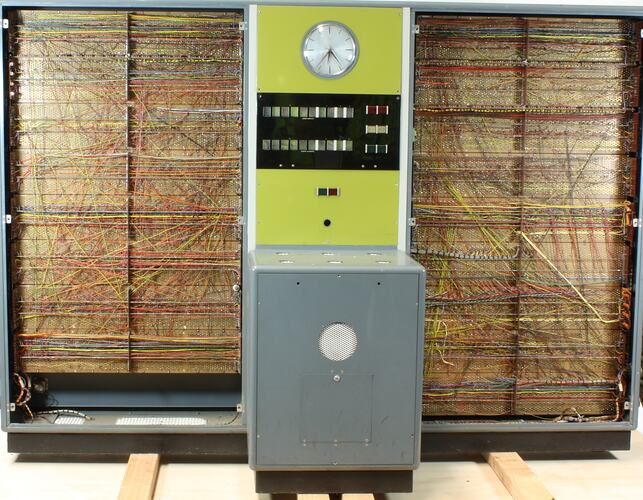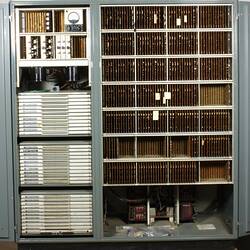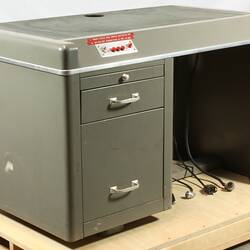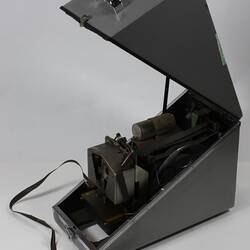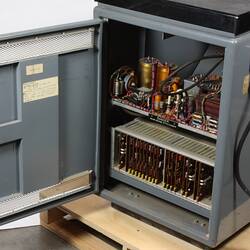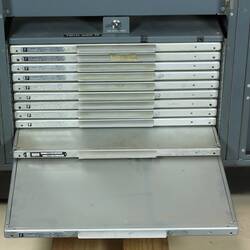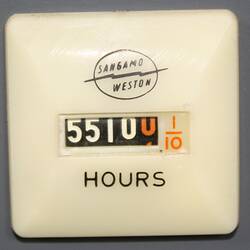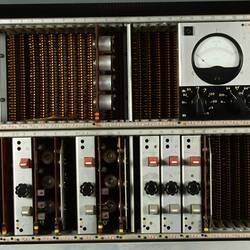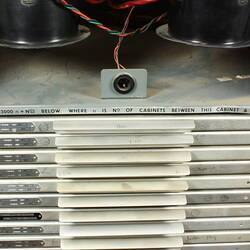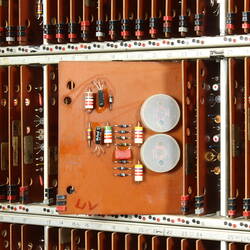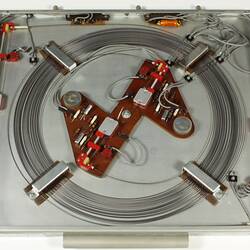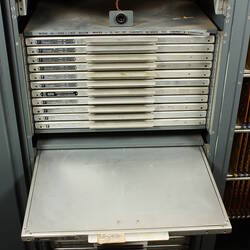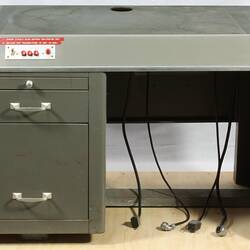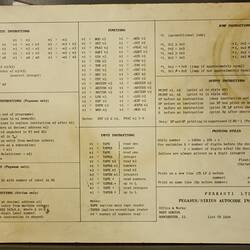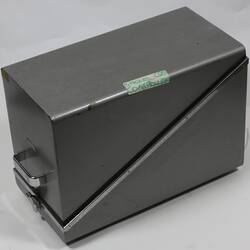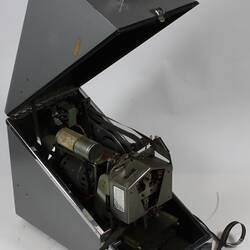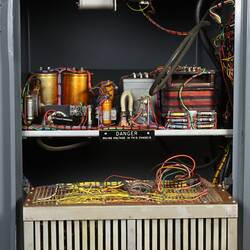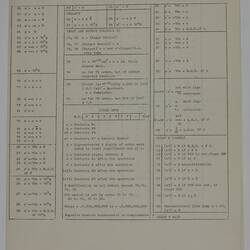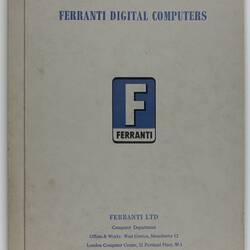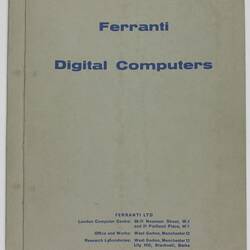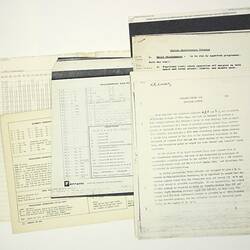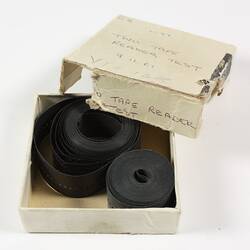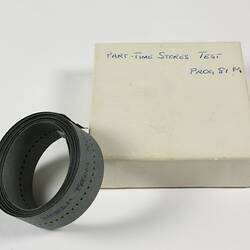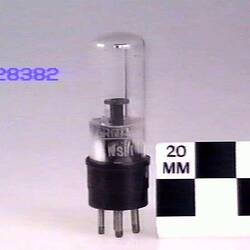Summary
The Ferranti Sirius is a small business computer first produced in the United Kingdom in1961. It was designed to be used in a normal office environment, without specialised cooling or power supply requirements.
The Ferranti Sirius in the Museum Victoria collection was donated by Monash University in 1975.
Research by Monash University Computer Museum (circa 2008) indicates that it is highly likely that the Ferranti Sirius in the Museum Victoria Collection is the one donated by ICIANZ to Monash in 1967 and used by the Chemistry Department. Monash University Computer Museum also has a Sirius in its collection (as of 2012).
Monash University donated hardware, software and paperwork to Museum Victoria. The donation included items from both ICIANZ and Monash University, but it has not been always possible to identify to which institution every item belonged. In March 2013, a researcher from Monash University Computing Museum identified the sources of as many of the items as she could. Any confusion about the provenance of Museum Victoria's Sirius possibly arises from the mixing up of records when the Monash Computer Centre was relocated in 1972-3.
The Sirius used decimal arithmetic rather than binary. It also made use of the Autocode programming system originally developed for Ferranti's Pegasus computer and so specialised programming staff was not required.
Physical Description
The computer system is not complete; the following items are in the Museum's collection: 1. Central processor: large greyish metal cabinet, made up of three sections with a smaller box in front of the centre section. A clock and a set of control lights are set into the front face of the centre cabiney. 2. Two memory units: each is a featureless shiny grey metal cabinet. Uunits contain banks of memory modules and circuitry. 3. Tape edit set: shiny grey metal desk unit with tapered front edge, on which is set a small control pane 4. Tape reader 5. Tape punch: rectangular shiny grey metal box with hinged lid, which, when lifted, reveals the paper tape punch mechanism 6. Keyboard: Roughly rectangular shiny grey metal box with gently sloping mainly numeric keyboard. 7. Current probe, lamp extractor, circuit board and connecting cable. There are over 45 rolls of punched paper tape carrying data and programmes. Reference and other material includes: manuals, booklets, documents, log books, print-outs, drawings and diagrams, and videos.
Significance
The Ferranti Sirius is one of the first computers to be produced to fit into an office environment rather than needing a purpose built room and dedicated staff.
The Sirius was designed as a general purpose computer with sufficient versatility, speed and reliability to carry out the requirements of a wide range of organisations that, nevertheless, did not need the larger installations needed by mainframes such as the CDC 3200. The reduced physical size and increased capacity of the Sirius was due to the development of miniaturisation as well as the increasing sophistication of the computer industry.
Ferranti had developed the world's first commercially available general-purpose computer, the Ferranti Mark 1 in 1951. The Mark 1 was the result of a partnership with Manchester University, England. The University had produced the very first electronic stored program computer, the Manchester 'Baby', in 1948. The Mark 1 was based on the 'Baby' and the Sirius was one of its descendants.
More Information
-
Collecting Areas
-
Acquisition Information
Donation from Monash University, Jun 1975
-
Manufacturer
Ferranti, Hollinwood, Lancashire, England, Great Britain, 1961
-
User
Chemistry Department, Monash University, Chisholm Campus, Caulfield, Greater Melbourne, Victoria, Australia, 1967-1972
-
Inscriptions
Central processor: White sticker on one end: MONASH UNIVERSITY / COMPUTER DEPARTMENT / EQUIPMENT REGISTER / No e 76 Memory unit (ST29037.2) : Top memory module: (Ferranti logo) SER. NO. 2 P 00446 / A. 1999.5 (plus over minus) 1.0 BITS / B 1999.5 (plus over minus) Memory unit (ST29037.8) : Top memory module: (Ferranti logo) SER. NO. 2 P 00650 / A. 1999.5 (plus over minus) 1.0 BITS / B 1999.5 (plus over minus) Tape edit set: Metal plate at back of unit: CREED & CO. LTD. / LONDON / PATENT No. / MODEL No. S.4060 / SERIAL No. 1709 / CUSTOMERS MARKING GRP74 Tape punch: label inside front box: TELETYPE / REG U.S.PAT. OFF. / MANUFACTURED BY / TELETYPE CORPORATION / CHICAGO U.S.A.
-
Brand Names
-
Classification
-
Category
-
Discipline
-
Type of item
-
Part Dimensions
2070 mm (Length), 600 mm (Width), 1450 mm (Height)
Dimensions of Central Processing Unit.
-
Part Dimensions
1270 mm (Length), 520 mm (Width), 1445 mm (Height)
Dimensions of each Memory Unit.
-
Part Dimensions
1060 mm (Length), 640 mm (Width), 690 mm (Height)
Dimensions of Tape Edit Set.
-
Part Dimensions
390 mm (Length), 270 mm (Width), 170 mm (Height)
Dimensions of Keyboard.
-
Part Dimensions
260 mm (Length), 510 mm (Width), 355 mm (Height)
Dimensions of Paper Tape Punch.
-
References
[Book] Rood, Sarah. 2008. From Ferranti to Faculty., 2008
-
Keywords
